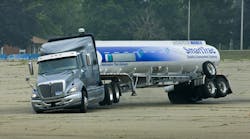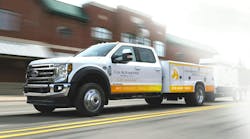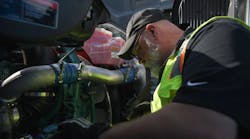There is no doubt that intelligent vehicle safety technologies have made heavy trucks safer than ever before. Two such technologies that have been shown to reduce crashes, injuries and fatalities, and thus help reduce operational costs - are electronic stability control (ESC) systems and roll stability control (RSC) systems.
Basically, RSC is designed to mitigate on-road, untripped truck rollovers by automatically decelerating the vehicle by applying the foundation brakes and reducing engine torque output. ESC includes the RSC function, but adds capability that allows the system to also mitigate severe oversteer or understeer conditions that can lead to vehicle loss-of-control.
The ESC system does this by automatically applying selective brakes to generate a yawing movement that helps the driver maintain directional control of the vehicle. Thus, ESC is designed to mitigate both untripped rollover and loss-of-control crashes.
RSC was introduced first in 2003; ESC in 2005. Two main companies that offer these advanced vehicle safety technologies are Bendix Commercial Vehicle Systems - a company that develops and supplies leading-edge active safety technologies, air brake charging and control systems and components under the Bendix brand name for medium and heavy duty trucks, tractors, trailers, buses and other commercial vehicles throughout North America, and Meritor Wabco - the leading supplier of braking systems and controls and active safety systems for commercial vehicles in North America.
BENDIX SYSTEMS
Bendix has two stability systems: the Bendix ESP and the Bendix Wingman ACB (Active Cruise with Braking). The Bendix ESP is a full-stability technology designed to help drivers mitigate loss of control and rollover situations on dry, wet, snow and ice-covered roadways, says Fred Andersky, the company’s director of marketing - controls. The system does this by applying select brakes and reducing throttle, slowing the vehicle down, and helping to keep the driver in control.
Bendix ESP utilizes standard ABS brake components, such as wheel speed sensors, modulators and an electronic control unit (ECU), along with some additional components, including yaw rate/lateral accelerometer, steering angle and pressure sensors.
If there is an issue with the system, the automatic traction control (ATC) lamp or stability system lamp (ESP or ESC) will remain lit, according to Andersky. If the vehicle ABS system is also affected, both the ABS warning lamp and the ATC or stability lamp will illuminate. In these situations, the vehicle will have partial or no stability function, but is still drivable and should be scheduled for service as soon as possible.
The Bendix Wingman ACB includes an additional feature of cruise control that takes an adaptive approach, Andersky says. When using cruise control, the system will maintain the set speed and intervene (including braking), as needed, to help maintain a set following distance (typically 2.8 seconds) behind a vehicle ahead in the same lane. The system features include an always-on audio and visual warning system.
The active interventions features of the system are automatically activated when the cruise control is turned on and speed is set. Using a radar sensor mounted to the front of the vehicle (typically behind the bumper), the Bendix Wingman ACB system monitors up to 32 objects within approximately 500 feet of the front of the vehicle.
If the forward vehicle slows down below the cruise control set speed, the system will de-throttle the engine, progressively apply the engine retarder, and then, if necessary, apply the foundation brakes in an attempt to maintain the set following distance behind the forward vehicle, he explains. If the forward vehicle accelerates away, the vehicle will automatically accelerate back to the original cruise control set speed.
Since the Bendix Wingman ACB operates with normal cruise control, all the features built into normal cruise control also apply. Limits imposed by factory-set road speed governors or other vehicle cruise control features are fully supported by the system.
A key preventive maintenance measure to keep the Bendix Wingman ACB system functioning properly is to keep the radar clean and free of obstructions, says Andersky. It is recommended that drivers regularly check the radar sensor to ensure that it is free and clear of mud, snow, dirt, ice or other obstructions. The sensor does contain a heating element to help reduce the build-up of ice and snow, but drivers should check at each walk around or stop nevertheless.
If the sensor is blocked, the driver will get a diagnostic trouble code (DTC) and a light will appear on the dash. Any vehicle trouble code that disables vehicle cruise control will also cause a trouble code in Bendix Wingman ACB.
MERITOR WABCO
Meritor Wabco offers several stability control systems:
- Roll Stability Support RSSplus Trailer. The next generation of Meritor Wabco’s roll stability support system, RSSplus helps the driver maintain trailer and overall vehicle stability while integrating ABS, Power Line Carrier (PLC) communications for the transfer of data to an in-cab PLC display and telematics capability for transmitting real-time trailer data to fleet headquarters.
The system simultaneously monitors trailer wheel speed, lateral acceleration and suspension pressure. If the vehicle approaches its rollover threshold, RSSplus automatically applies trailer brakes as needed in order to reduce the risk of rollover and help bring the vehicle under control.
The system’s operating data recorder, which has a built-in odometer, stores such information as RSS activations, ABS activations and number of brake activations.
RSSplus is for aftermarket retrofits on trailers already equipped with Meritor Wabco ABS or a different ABS brand, and is available for air or spring suspension equipped trailers.
- OnGuard Collision Safety Systems. This system incorporates with Adaptive Cruise Control (ACC) and Active Braking to assist the driver in maintaining a safe following distance (3.6 seconds). It is also a Collision Mitigation System (CMS) that detects a potential rear-end collision developing ahead and responds by braking as needed to assist the driver in avoiding a collision.
OnGuard uses forward-looking radar sensor technology featuring advanced algorithms to monitor the distance, speed and deceleration of a vehicle ahead. When OnGuard detects that a potential collision is developing, it sends audible and visual warnings through an in-cab dash display so the driver is alerted to take the appropriate corrective action.
If a rear-end collision is developing without the driver taking action to decelerate the vehicle, the system automatically de-throttles the engine and applies the engine and foundation brakes to provide up to 0.35Gs of braking power - equivalent to one-half brake power.
This reaction time reduction can help the driver to either prevent a collision or greatly reduce its impact, say Meritor Wabco officials. They note that the National Highway Traffic Safety Administration says 90 percent of rear-end accidents caused by delay in driver recognition can be prevented if the driver is able to recognize the situation one second earlier.
- SmartTrac Stability Control Systems. The SmartTrac family of Stability Control Systems integrates active safety systems technologies into a comprehensive suite of products to meet specific operational needs. It includes Anti-Lock Braking Systems, Automatic Traction Control (ATC) and Stability Control Systems for truck, tractor and trailer, officials say.
Meritor Wabco Roll Stability Control is an active vehicle safety system that assists drivers in maintaining control of the vehicle by continually monitoring conditions that can lead to a rollover, and automatically intervenes if a high rollover risk is detected. The system checks and updates the lateral acceleration of the tractor and compares it to a critical threshold at which rollover may occur. It intervenes by reducing engine torque and engaging the engine retarder while automatically applying drive axle and trailer brakes.
The company’s Electronic Stability Control (ESC) combines RSC with the added capability of yaw or rotational control. It can assist the driver in reducing the risk of vehicle instability and the potential for jackknifing and driftout conditions through select braking of the tractor and application of the trailer brakes. If loss of stability is detected, tractor-trailer speed is reduced through engine control and application of the engine brake, tractor and trailer foundation brakes.
- SafetyDirect Fleet Performance System. Through a strategic partnership with Iteris, this system gives users a single point of access to monitor and synchronize driver performance reports on braking, stability control, following distances, collision safety system braking and lane-departure warnings for individual drivers, as well as the entire fleet. The comprehensive reporting includes event location, date, time, speed, odometer reading and safety trending data.
A web-based reporting tool, SafetyDirect uses an onboard data logger to capture and report driving behavior, vehicle characteristics and severe events. The data logger is installed on the vehicle and interfaces with the truck’s SAE J1939 data link. Data is automatically saved and transferred, using an existing telematics provider, to a website, where it can be accessed by fleet managers.
With SafetyDirect, fleet managers are able to set parameters and individual thresholds for severe events and get automated, customized reports. They can get a comprehensive view of the entire fleet, or drill down to detailed information on individual drivers and events.
SafetyDirect enables users to compare the performance of drivers within a fleet - even track their performance in different trucks, monitoring each driver’s or group’s performance over time.
SafetyDirect also provides important information on vehicle and equipment status. It monitors the safety system status, including Lane Departure Warning DW, OnGuard and SmartTrac stability control systems. In addition, SafetyDirect monitors fuel mileage and safety system fault codes.
OBJECT DETECTION
Another type of vehicle safety technology is obstacle detection systems. This technology can monitor side and rear blind areas or “no zones” for vehicles and pedestrians in order to see what the human eye cannot, says Kirk Knobel, sales and marketing manager for Transportation Safety Technologies (TST), a leader in the design and manufacture of a wide array of electronic components for all types of commercial vehicles.
Obstacle detection systems “provide drivers with obstacle location and precise distance information to identify hazards in blind spots during lane changes, backing or other maneuvers frequently encountered on a crowded job site,” he says.
There are obstacle detection solutions that provide drivers with both audio and visual early warning systems to help them avoid dangerous situations and improve overall driver hazard awareness, he notes. For example, a driver hears the words “right side,” while an LED message simultaneously appears on the screen.
Many obstacle detection systems consist of multiple rugged, weather-resistant sensors strategically mounted around the vehicle and a single driver alert module inside the cab, usually dash-mounted. The systems work when users are driving fast or slow, backward or forward.
TST’s Eagle Eye Obstacle Detection System, for example, consists of up to seven sensors that can be mounted anywhere on the vehicle, cab or trailer, “wherever the driver needs an extra set of eyes,” says Knobel. The dash-mounted digital display provides an audible warning and a distance measurement to the driver of potentially hidden obstacles that are within 10 feet of the vehicle during key maneuvers such as backing up or changing lanes.
Most systems are easy to install aftermarket and the best are “plug-‘n-play” products, he says. They can be installed by a technician with little training in less than two hours, and less than one hour for many configurations. Users can be trained on how to perform the installation on their own, or the vendor can handle installation. The system requires no regular maintenance costs.
“Having this extra set of eyes plays a huge role in helping drivers to avoid damage, injury and accident costs, and significantly lowers overall operating costs, while boosting productivity, ” says Knobel.
CAMERA SYSTEMS
Onboard video camera systems for object detection on commercial vehicles can also improve safety and reduce accidents, especially while backing. These systems allow drivers to see considerably more than is possible when using conventional mirror systems.
Camera systems come with an in-cab monitor and camera components which allow for multiple cameras to be configured with easy installation, and located and customized for each vehicle’s blind spot needs, says Brandon Stotsenburg, vice president of sales and marketing for Mobile Awareness, a company that designs, develops and markets transportation safety products utilizing leading-edge sensor technology. Camera options include heated cameras, night-vision options and flush-mount bullet options.
One of Mobile Awareness’ offerings, VisionStat Plus, is a vehicle safety technology that integrates an obstacle detection sensor system with a rearview (back-up) camera system to aid in preventing backing accidents.
With VisionStat Plus, distance and proximity information from the vehicle-mounted sensors are displayed on the in-cab monitor and the driver is provided both audio and visual information when an obstacle is detected at the rear of the vehicle, he says. The driver sees the exact distance - accurate to 1 inch - to the closest object on the monitor.
Obstacle detection systems that offer “active” (audible where the driver is warned without having to view the monitor) warnings are extremely effective for backing environments, notes Stotsenburg. The system detects both “hard” objects as well as “soft” (people), and can improve the efficiency of backing into docks, as well as in unfamiliar customer locations.
TRACKING TECHNOLOGY
Another type of technology that can help reduce accidents is satellite- and cellular-based mobile two-way communication tracking systems that wirelessly emit, transmit and receive information to monitor and track vehicles in real-time, as well as GPS-based fleet management solutions.
By way of example, Telogis Fleet, a Software-as-a-Service (SaaS) GPS fleet management system allows fleet managers to enter business rules and receive notifications of violations so they can better monitor operations, says Sean McCormick, a product manager with Telogis, a platform for location intelligence. Alerts can be defined on a range of parameters, including key employee/asset safety factors, such as hard braking, hard swerving and speeding against posted speed limit.
Telogis Fleet also helps with employee safety as it has the ability to integrate features such as panic buttons that can provide immediate notification to the right person so the right protocol can be followed to ensure worker safety.
In addition, routing solutions can help companies plan optimal routes and schedules, and there is an inherent safety factor to that, he says. “Optimal routes mean trucks are spending less time on the road. Less time on the road means less exposure to potential safety violations and incidents.”
There are routing solutions like that feature real-time traffic and weather, which allows fleet managers to re-route trucks in the field based on congestion, and alert drivers to the potential of dangerous weather moving through the area.
Telogis Fleet’s new “What Happened Here” feature is a tool that simplifies the process of researching incidents at specific locations/times, says McCormick. It quickly accesses historical data to help expedite investigations into purported violations or incidents involving a company’s vehicles.
MANAGEMENT TOOLS
Beyond safety, mobile communications tracking systems can enhance security and efficiency of commercial vehicle operations by providing information about asset locations and a direct means of communication between carrier personnel and drivers. By closely tracking vehicles and assets, opportunities for cargo and vehicle theft can be reduced.
Fleet management software, such as XataNet and Xata, use mobile communication tracking systems to provide real-time data that tells exactly vehicles are - whether they’re parked in the yard, idling at a customer’s location or traveling down the interstate, says Christian Schenk, vice president of product marketing for Xata Corporation, a company that provides intuitive, automated fleet management software solutions to the trucking industry. Knowing where a fleet’s drivers and vehicles are - and what they’re doing - at all times helps keep them safe and secure, and also helps reduce theft.
“Thanks to asset tracking, fleet managers now have an easy way to locate their vehicles, he says, and they can choose how they want to view that data: road, aerial or bird’s eye mapping views, or even last-known location,” he says. “This same mobile communications technology can be used by fleet managers, dispatchers and drivers to keep in touch with one another.”
Qualcomm, through its integrated Trailer Tracks wireless systems, provides timely information about load status and trailer locations for tethered and untethered trailers. This helps fleets monitor the status and location of trailers and containers in near real-time, increase driver and tractor productivity, optimize asset utilization and trailer pool inventory and maintain visibility in harsh environments.
DRIVER BEHAVIOR
Earlier this year, to help fleets reduce crashes and minimize operating costs, Zurich, one of the largest fleet insurers, began a new program that combines its in-depth understanding of fleet insurance, operations and risk engineering to create Zurich Fleet Intelligence (ZFI).
ZFI “allows fleet managers to understand the behaviors of their drivers, while also giving them access to a Zurich risk engineering specialist who can work with them to help improve their drivers' performance, in turn helping them reduce their fleets' operating costs and run a safer fleet," said Paul Horgan, chief underwriting officer for Zurich Global Corporate in North America. "It really takes the benefits of telematics data to the next level."
ZFI works by combining data from the top telematics providers with Zurich's extensive analytical tools to turn the data into meaningful insights that can help fleet managers:
- Optimize vehicle journey planning and deployment.
- Reduce vehicle running costs.
- Achieve increased fuel economy.
- Reduce the occurrence of vehicle crashes through defensive driver training.
- Influence future insurance premiums.
- Improve employees' driving skills and knowledge.
- Reduce stress and fatigue amongst drivers through coaching and development.
- Improve their fleet's impact on the environment.
Zurich's findings, as well as findings from a recent study conducted by the Federal Motor Carrier Safety Administration, show significant safety benefits and a reduction in a variety of at-risk driver behaviors when fleets use in-vehicle monitoring devices. Specifically, studies have shown that using driver behavior monitoring systems can help fleet managers to improve driver safety by reducing collisions up to 20 percent, improve efficiency by reducing costs up to 10 percent and improve CO2 emissions by reducing fuel consumption up to 11 percent.




